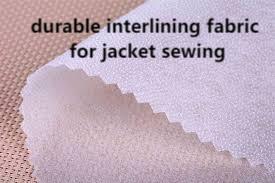Reinventing Apparel Performance With Interlining From Interlining-Factory

In contemporary garment making, hidden layers can determine whether a piece endures or quickly loses its shape. Designers routinely rely on Interlining to add structure and resilience, and when placed with care, Interlining helps garments retain tailored lines and deliver consistent wear. This subtle element influences fit, finish, and longevity without drawing attention — yet its engineering and application are pivotal to professional results.
Structural Support That Lasts
A garment’s first impression often comes from its silhouette. Reinforcement beneath collars, lapels, and waistbands preserves crisp lines and a premium appearance. Properly selected inner layers distribute stress, prevent sagging, and reduce distortion after washing. For tailored pieces, these unseen components are essential to maintaining the intended drape and visual integrity through repeated wear.
Precision Fit and Enhanced Comfort
Perfecting fit involves more than cutting and stitching; it requires thoughtful internal architecture. Strategic reinforcement supports seams and edges while allowing movement where needed. Lightweight constructions can provide subtle shape without bulk, and breathable options minimize heat buildup. The result is clothing that looks sharp but remains comfortable during real-world use, meeting consumer expectations for both style and ease.
Manufacturing Practices and Application Techniques
How reinforcement is attached makes a large difference in appearance and durability. Thermal bonding, sewing, and adhesive methods each suit different fabric types and production workflows. Automated processes improve consistency for large runs, while hand-applied techniques can benefit couture and small-batch producers. Attention to lining placement and edge finishing prevents show-through and ensures the inner layer functions harmoniously with the outer fabric.
Interlining-Factory Standards And Quality Control
Sourcing reliable materials and maintaining rigorous inspection protocols reduce product failures in the field. Vendors that test adhesion, tensile strength, and wash resistance provide predictable performance for manufacturers. Quality control steps — sampling, batch testing, and supplier audits — help integrate internal reinforcement with garment assembly seamlessly, lowering rates of returns and consumer complaints.
Sustainability And Material Innovation
Environmental concerns are reshaping material choices and production methods. Recycled fibers, lower-emission bonding processes, and recyclable constructions are becoming mainstream. Designers and producers increasingly prioritize solutions that extend garment life, reducing the need for replacement and lowering the sector’s overall footprint. Advances in bio-based and engineered synthetic options are expanding possibilities for recyclable reinforcement without sacrificing performance.
Application Across Product Categories
Different garment categories have distinct reinforcement needs. Formal wear often requires heavier, more structured options to hold tailored shapes. Casual and activewear favor lighter, stretch-compatible constructions that move with the wearer. Workwear and uniforms benefit from tougher, abrasion-resistant inner layers designed to withstand demanding conditions. Matching the reinforcement type to the end use is critical for balancing durability and comfort.
Educating Designers And Technicians
Bridging the gap between textile chemistry and apparel construction requires knowledge sharing. Workshops, specification guides, and technical datasheets help pattern makers and production teams understand how choices affect the final product. Clear care instructions for consumers also preserve garment performance: correct laundering and handling minimize degradation of internal layers and extend usable life.
Looking Ahead: Smart Materials And Adaptive Performance
Emerging technologies point toward reinforcement that adapts to use and environment — for example, materials that respond to moisture or temperature to modulate stiffness, or composites that combine stretch and recovery for dynamic fit. Integration with digital design tools can also allow virtual testing of reinforcement placement, accelerating iteration and reducing waste.
In sum, thoughtful internal reinforcement transforms garments from transient items into durable, well-performing pieces. From production techniques to sustainable sourcing and future smart materials, the hidden layer continues to play a front-line role in apparel innovation. For more detailed information on types, applications, and best practices, visit https://www.interlining-factory.com/news/what-is-interlining-types-applications-and-more.html
- Art
- Causes
- Crafts
- Dance
- Drinks
- Film
- Fitness
- Food
- Oyunlar
- Gardening
- Health
- Home
- Literature
- Music
- Networking
- Other
- Party
- Religion
- Shopping
- Sports
- Theater
- Wellness
